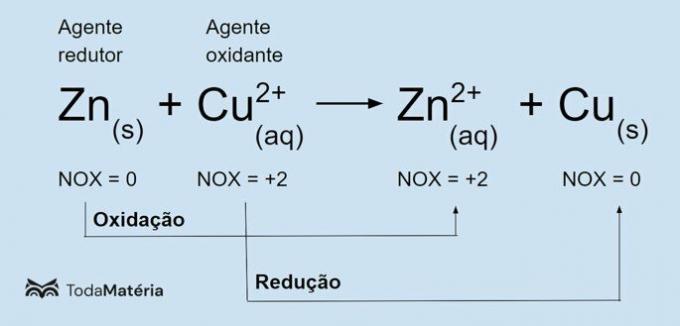Nox (oxidation number) is the charge an element acquires when making an ionic bond, or the partial character it acquires when making a covalent bond.
The texts "Concept of Oxidation Number (NOx)” and “Determination of the Oxidation Number (Nox)” show how to calculate the Nox of simpler substances. However, there are cases of more complex structures, such as organic compounds, which have several atoms of the same element linked in different ways to each other or with other chemical elements.
Organic compounds are usually made up of carbon and hydrogen, but oxygen and nitrogen are also very common. Thus, since they have several carbon atoms in their structures, each of them has different Nox, depending on the elements with which they are linked.
For example, let's see how to determine the Nox for each of the carbons present in the glucose structure below:
OH OH OH H OH O
│ │ │ │ │ ║
H─C─C─C─C─C─C
│ │ │ │ │ │
H H H H H H
Let's first number the carbons to differentiate them, starting from the carbon at the end that is making a double bond with oxygen, that is, the carbon in the carbonyl group:
OH OH OH H OH O
│ │ │ │ │ ║
H─C6 ─C5 ─C4 ─C3 ─C2 ─C1
│ │ │ │ │ │
H H H H H H
Note that carbon 1 is bonded to a hydrogen, an oxygen, and another carbon, as shown below. However, its bond with the other carbon does not interfere with its Nox, as both have the same electronegativity.
O → Nox = -2
║
Ç2 ─C1→ Nox = x
│
H → Nox = +1
On call Ç and H, carbon is more electronegative than H, receiving an electron from it. In the case of the call Ç and O, oxygen is the most electronegative, removing two electrons from carbon. So, the Nox of this carbon will be given by considering the total losses and gains of electrons, that is, if it gained one electron and lost two, then its Nox is equal to +1.
Do not stop now... There's more after the advertising ;)
Now let's look at carbon number 2:
oh → Nox = -1
│
Ç3 ─C2 ─C1
│
H → Nox = +1
This carbon received an electron from the H and lost an electron to the hydroxyl (OH); with that, your resulting Nox is equal to zero.
Note that carbons 3, 4, and 5 make exactly the same bonds as carbon 2; so their Nox are also equal to zero. It remains to discover the Nox of carbon 6:
oh → Nox = -1
│
Ç5 ─C6 ─ H→ Nox = +1
│
H → Nox = +1
Since it receives one electron from each H, it is therefore two received electrons; and it loses an electron to the OH, its Nox is equal to -1.
If we want to calculate the medium nox of carbon in glucose, just add all the Nox and divide by the amount of carbon, as shown below:
Six carbon nox → C6 ─C5 ─C4 ─C3 ─C2 ─C1
-1 0 0 0 0 +1
Medium Nox→ (-1) + (0) + (+1) = zero
6
But what if we don't know the structure of the compound, how do we go about determining Nox?
In this case, it is not possible to determine the Nox for each of the elements, but it is possible to determine the average Nox from the molecular formula. See how this is done with the molecular formula of glucose itself (C6H12O6):
Ç6 H12 O6
6x + 12. (+1)+ 6. (-2) = 0
6x + 12 -12 = 0
6x = 12 - 12
x = 0
By Jennifer Fogaça
Graduated in Chemistry
Would you like to reference this text in a school or academic work? Look:
FOGAÇA, Jennifer Rocha Vargas. "Nox in Complex Structures and Medium Nox"; Brazil School. Available in: https://brasilescola.uol.com.br/quimica/nox-estruturas-complexas-nox-medio.htm. Accessed on June 28, 2021.
Chemistry

Photosensitive lenses, oxidation-reduction reactions, loss or gain of electrons, photosynthetic lenses in sunglasses, composition of photochromatic glass, tetrahedral oxygen atoms, crystal structure of silver chloride, ultraviolet light, silver metal

